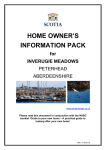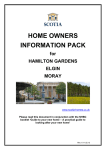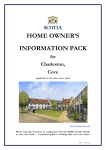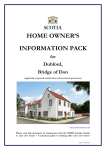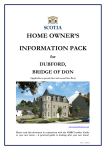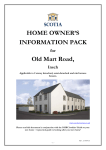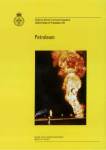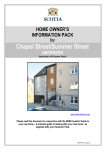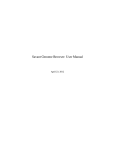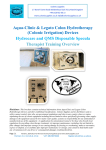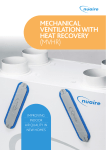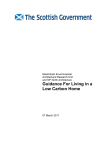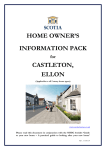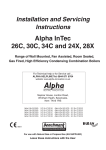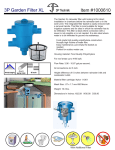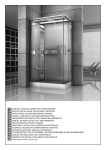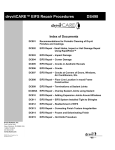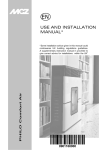Download File - Scotia Homes
Transcript
HOME OWNER’S INFORMATION PACK for Burnside DYCE Aberdeenshire (Applicable to the Townhouse Type A and B house types) www.scotia-homes.co.uk Please read this document in conjunction with the NHBC booklet ‘Guide to your new home – A practical guide to looking after your new home’ Rev. 2 10.09.13 Contents Page GENERAL MAINTENANCE AND SAFETY __________________________ 4 OPERATING INSTRUCTIONS FOR GAS-FIRED CENTRAL HEATING, HOT WATER AND COLD WATER SYSTEMS ____________________________ 4 HOMESERVE EMERGENCY COVER ______________________________ 6 RADIATOR SAFETY PRECAUTIONS ______________________________ 6 HEATING AND HOT WATER INSTALLATION _______________________ 7 GAS SYSTEM ________________________________________________ 8 HOT AND COLD WATER SERVICES ______________________________ 8 KITCHENS ___________________________________________________ 9 MVHR VENTILATION SYSTEM __________________________________ 10 VENTILATION AND AVOIDING CONDENSATION___________________ 10 COMMUNAL DIGITAL TELEVISION AND SATELLITE INSTALLATION __ 11 TELEPHONE INSTALLATION ___________________________________ 12 WINDOWS AND FRENCH DOORS _______________________________ 12 ROOF WINDOWS ____________________________________________ 13 OPERATING INSTRUCTIONS FOR THE ELECTRICAL INSTALLATION _ 15 IF AN ELECTRICAL CIRCUIT FAILS _____________________________ 15 SMOKE & HEAT DETECTORS __________________________________ 16 EXTERNAL DOORS __________________________________________ 16 INTERNAL DOORS ___________________________________________ 17 FIRE RATED INTERNAL DOORS ________________________________ 17 Rev. 2 10.09.13 FIRE RATED HOUSE/GARAGE INTERNAL DOOR __________________ 18 WALL TILING ________________________________________________ 18 SHOWER WALL PANELLING ___________________________________ 18 FLOOR FINISHES ____________________________________________ 18 ROOF SPACE _______________________________________________ 19 CONSTRUCTION OF WALLS, PARTITIONS, FLOORS & CEILINGS ____ 19 EFFLORESCENCE ON EXTERNAL WALLS _______________________ 21 FIXING TO WALLS, CEILINGS OR FLOORS – IMPORTANT NOTICE ___ 22 EXTERNAL FIXINGS __________________________________________ 22 METERS ____________________________________________________ 22 EXTERNAL AREAS ___________________________________________ 22 ROOF RAINWATER SYSTEM ___________________________________ 24 SURFACE AND RAIN WATER DRAINAGE CONSIDERATIONS ________ 24 LOCAL AUTHORITY REFUSE AND RECYCLING COLLECTION _______ 27 COUNCIL TAX _______________________________________________ 27 SCHEDULE OF TEST CERTIFICATES ____________________________ 27 SCHEDULE OF MATERIALS ___________________________________ 28 NOTE: The information contained in this document is for our standard house types and may not cover specific variations requested by you. -3- GENERAL MAINTENANCE AND SAFETY Regular maintenance work is required for all homes to keep them at their best in the years to come and to ensure that they continue to be a safe home environment. We recommend that you employ competent tradesmen/contractors to carry out the maintenance work, however if you decide to carry out maintenance work (or alteration works) on your home yourself, then there follows a list of some of the basic rules to bear in mind; Always plan the job thoroughly in advance. Consider any risks- is there adequate ventilation? Do you need any safety equipment? Can the job be done another way to make it safer? If you are in doubt then do not attempt the job yourself – seek advice from a professional or employ a skilled tradesman or contractor. Check any materials you are going to use for any warnings or precautions and heed the material safety recommendations. Always use the right tools for the job and use them in accordance with their instructions. If you intend to work at height please be aware of the risks involved. Try to avoid working at height if at all possible but if you decide it is necessary then please make sure your ladder or stepladder is in good condition and securely held in place. There is a large amount of information and recommendations available on the subject of working at height on the internet or in most good public libraries – take the time to familiarise yourself with the risks and recommendations involved in working at height before carrying out the job. Note that we advise that you use a specialist roofing contractor if your roof requires maintenance work. If there is risk involved, try and avoid working alone. Dispose of any surplus materials and waste according to the manufacturer’s instructions, adherence to Local Authority waste regulations, and consideration for the environment. Always keep a well stocked first aid kit. Please also refer to your NHBC ‘Guide To Your New Home’ for more information on maintenance. OPERATING INSTRUCTIONS FOR GAS-FIRED CENTRAL HEATING, HOT WATER AND COLD WATER SYSTEMS Introduction Your home has been fitted with a gas-fired heating system serving radiators and a domestic hot water supply. -4- The gas–fired boiler is located in a ground floor cupboard and you will find the operating and maintenance instructions for the boiler in your handover pack. If, after referring to the user information on boiler controls in the boiler instruction manual, you are unable to find the answers to any boiler problems and the problem is an emergency which has arisen during the first 24 months after your legal date of entry to the house, then please contact HomeServe (please see section on HomeServe below for more details). If the fault is not an emergency (as described in the HomeServe cover summary) then please contact Scotia during normal office hours. You are responsible for the annual maintenance and servicing of the boiler, this should be arranged through any reputable, Gas Safe registered plumbing and heating contractor. Heating and Domestic Hot Water Controls The system has the following controls:1. Boiler isolating switch. 2. Programmable Room Thermostats (2 are provided - located in the master bedroom and in the ground floor or first floor hall) 3. Thermostatic radiator valves to radiators (except on the by pass radiator/s) 4. Frost thermostat Boiler Isolating Switch This switch will be found on the wall next to the boiler in the ground floor boiler cupboard. This switch is to isolate the electrical supply to the boiler and should be left on at all times. Only use this switch if a fault develops on the boiler. Programmable Room Thermostats Your home has a 2 zone heating system which gives you more flexibility with heating than in a ‘traditional’ one zone heating system. One zone covers the heating to the bedrooms, en-suite (where applicable) and bathroom, the programmable room thermostat for this is located on the wall in the master bedroom. The other zone covers the drawing room, kitchen, utility (where applicable), ground floor toilet (where applicable) and ground, first and second floor halls, the programmable room thermostat for this is located on the wall in either the ground or first floor hall. The programmable room thermostats control the boiler, telling it when you require central heating and hot water. The programmer has the facility to give several on/off times. Temperatures can also be selected for each on/off time. When the heating is selected on the system it will operate until the set temperature is achieved. The temperature is measured in the hallway by the remote temperature sensor. When the system is selected off, the boiler will not operate unless the temperature in the hallway or master bedroom drops below the setback temperature selected. You can select your minimum desired house temperature, normally this can be set between 12 and 16°C. Please refer to the manufacturer’s instructions in your handover pack for further instructions. -5- Thermostatic Radiator Valves Thermostatic Radiator Valves (TRV’s) are fitted for comfort control i.e. 1 – low level heat, 5 – maximum level heat. They are fitted to all radiators except radiators in rooms where there is a room thermostat. They are essential to the full efficiency of your heating system and allow you to lower temperatures in unoccupied rooms thus reducing heating costs. TRV’s sense room temperature changes in individual rooms and adjust the flow of heated water through the radiators to maintain the desired temperature. Depending on level of comfort required, 2 – 3 should be selected. Please refer to the manufacturer’s instructions in your Handover Pack for full details. Frost thermostat (only fitted where boilers are located in garage) In severe weather conditions the frost thermostat can override the time clock and start up the heating system to prevent frost damage to the boiler and pipe work. Central Heating Should your central heating or hot water fail to work, please ensure that all of the procedures laid out in the boiler manufacturer's literature are followed. Failure to do this may result in a charge being made for an unnecessary call out. Bleeding of Radiators This should not be required with a sealed system. However, radiators feeling warm but cold at the top would indicate air in the radiator. There are airing points normally at the top of the radiator. Use an air-bleeding key to turn clockwise to reduce air. You can do this by inserting the key and turning it anti-clockwise, then once the air stops a small amount of water will be discharged, quickly turn the key clockwise to tighten. Check pressure gauge on boiler, if it is below that recommended in the manufacturer's instructions, then it will be necessary to top up the system. See enclosed boiler user guide for full instructions. HOMESERVE EMERGENCY COVER Your home is covered under HomeServe’s Home Emergency Assistance Cover for a period of 24 months from your legal date of entry. This service provides emergency cover for your heating system in the event of a loss of central heating or hot water providing the equipment has been maintained and serviced in accordance with the manufacturer’s instructions. It also extends to blocked drains, burst pipes and damaged window and door locks where there is a risk to security. In an emergency situation (as defined in the Cover Summary as provided to you direct by HomeServe) where any of the above is affected you should contact HomeServe directly instead of Scotia. At the time of writing, the emergency contact number for HomeServe is 0800 247999. Where any problem is not classed as an emergency by HomeServe you should contact the Scotia customer care department during normal office hours. RADIATOR SAFETY PRECAUTIONS -6- Users should ensure that those who may come into close proximity to hot radiators are aware of the risks of burns. Users should take any necessary steps to minimise the risks of burns from hot radiators (for example where there are very young children in the room). Where applicable, consideration should be given to placing guards in front of the radiators or reducing the temperature of individual radiators by turning the thermostatic radiator valve to a low setting. Radiators are heavy items and are securely fastened to the wall on installation, with appropriate fasteners to secure the radiator bracket and suit construction of the wall. Decorative covers (such as the decorative perforated MDF or timber covers that you can purchase from DIY stores) will significantly reduce the output of a radiator and thermostatic radiator valves should not be fitted inside these radiator covers (as this will stop the valves from working efficiently). These covers are not recommended as they will, by consequence, impede an individual room’s heat requirement, which your new heating system has been carefully designed to provide. The only exception to this would be the comments above regarding safety of young children. if you do need to fit a radiator cover for this purpose then you should use one of the metal mesh type covers, similar to a fire place guard, which will not impede the flow of heat from your radiator into the room. Radiators should not normally be used for the mounting of clothes airers, cat beds or other such fixtures. The mounting brackets of the radiator are designed to support the weight of the radiator itself and water contents, allowing for an adequate safety margin, additional weight may compromise this margin and cause risk of failure, leaks and potential hot water burns. Appropriate facilities are required by Building Regulations for internal and/or external drying facilities and these are provided (please see “Ventilation and avoiding condensation”). Radiator-mounted airers and other devices may lead to excessive internal moisture and any chips/damage caused to the radiator itself may compromise the protective coating and potentially lead to corrosion/failure, which may not be covered by warranties. HEATING AND HOT WATER INSTALLATION Heating and hot water are provided by an Alpha FlowSmart System 50 which comprises a wall mounted, high efficiency, condensing combination boiler (Alpha InTec 34C) with a gas saver flue gas heat recovery unit and a 50 litre thermal store. For your information - this system combines the efficiency of a combination or ‘combi’ boiler with the convenience of having a store of hot water. A ‘traditional’ combination boiler system will only provide hot water when there is a demand but, due to limits on its ability to supply large volumes of hot water to several outlets simultaneously, it has drawbacks for larger properties. To overcome this, a system boiler with a big (typically 200 litre) hot water cylinder is traditionally used in larger houses. However, the Alpha FlowSmart System overcomes the problems of a combination boiler and provides the same accessibility to hot water as a system boiler with a hot water cylinder but in a space saving and efficient package. Please note that to obtain the maximum benefit both the thermal store and the gas saver flue must be switched on – turning them off will mean that you will lose the efficiency benefits and the available volume of hot water will be significantly reduced. -7- A full explanation of how the system has been installed and should be serviced is included in the installation and servicing instructions. The operation of the boiler is also fully explained in the enclosed boiler user instructions. A copy of the user manual, installation & service instructions, inspection, commissioning and service record logbooks for the system are enclosed with your handover pack. An annual gas service of the boiler and inspection/maintenance of the associated equipment, in accordance with the above instructions, is required to be carried out by Gas Safe registered personnel. Failure to carry this out will invalidate the manufacturer’s and NHBC warranties. GAS SYSTEM Never obstruct gas boiler flue outlets or ventilation, if provided, to the boiler. Never tamper with the gas installation or equipment. Any alterations to the gas supply pipework or work in construction with any gas appliance should only be carried out by Gas Safe registered personnel. If you suspect a gas leak: 1. Extinguish all naked flames. 2. Do not use any electrical switches or appliances 3. Turn off the gas at the meter. 4. Open all doors and windows. 5. Call the National Gas Emergency Service on its emergency number which is in the telephone directory under ‘GAS, Gas Emergency’. There is no call-out charge. The current emergency number at date of preparation of this document is 0800 111999. This service operates 24 hours a day and 365 days a year. HOT AND COLD WATER SERVICES Mains Cold Water Service The stopcock for the incoming cold water service is located under the kitchen sink (end-terrace townhouse – Type B) or within the ground floor boiler cupboard (midterrace townhouse – Type A). There is also a single mains incoming water service with a stopcock, which is located in the boundary box in the footpath. Domestic Hot Water The Alpha Flow Smart system produces domestic hot water in an energy efficient manner and the operation of this is fully explained in the enclosed Instruction -8- Manuals. Please also refer to the notes in the Heating and Hot Water Installation section above. External Water Tap (if fitted) Where there is a risk of severe frost, water supply to tap should be isolated, pipe work drained, and the tap should be left in the open position. Sanitary Ware/Taps Sanitary ware should be cleaned in accordance with the manufacturer's instructions which are enclosed in your Handover Pack. The manufacturer of the bath recommends the use of an anti slip mat when a shower is installed over the bath. Thermostatic mixing valve A thermostatic mixing valve to limit the hot water temperature at the bath tap to a maximum of 46°C is fitted below the bath. It is recommended that initial temperature checks are carried out six weeks after occupation of the property, and then an annual check is to be carried out to test the water temperature to ensure the maximum limit of 46°C is not exceeded. Hot Water Temperature (kitchen sinks and wash hand basins) The hot water from your kitchen sink taps and wash hand basins can be very hot depending upon the boiler settings. The hot water can initially have a low temperature as cooler water sitting in the pipes is discharged but can then become hot suddenly. Appropriate care should be taken to avoid risks of scalding. KITCHENS Kitchen Appliances, Sink Units and Worktops Refer to the manufacturer’s instructions for operating and cleaning of kitchen appliances, sinks, units and worktops, these are enclosed in your Handover Pack. Cooker Hood – Please note that the kitchen cooker hood has been installed for use in the recirculation mode and a special charcoal filter has been fitted. This charcoal filter normally requires changing after every three/four months or more frequently if used more than 3 hours a day. Replacement charcoal filters are available from online retailers. Please refer to the instruction manual for your cooker hood which is contained in your Handover Pack for more details, and for other important operating and maintenance information for your cooker hood. Connecting Appliances – (where applicable) When fitting a dishwasher or washing machine, please ensure the blanked end of the waste pipe tee piece has been removed. Note – this is not applicable where a ‘standing waste’ pipe has been provided. Please also ensure that the water supplies and wastes are securely connected to the pipework. -9- MVHR VENTILATION SYSTEM Your home has been fitted with a MVHR (mechanical ventilation with heat recovery) system. This MVHR system has significant benefits over the older ‘traditional’ method of providing ventilation to a home. A ‘traditional’ system uses individual bathroom extract fans and trickle vents through the heads of windows or fresh air inlets through the walls or roofs of a house. With a MVHR system the trickle vents through the windows and individual extract fans are replaced with a centralised system. The modern MVHR system uses a concealed duct system connected to a mechanical ventilation unit located in the attic space. This system draws warm, moist air from rooms such as bathrooms, kitchens and en-suites and passes it through a heat exchanger to remove the heat before venting the stale/ moist air to the outside. At the same time the unit also draws cool fresh air in from the outside and passes it through the heat exchanger which warms it with the energy taken out of the moist air before sending it to the living rooms and bedrooms. This means that the heat energy which would be lost in a traditional system is collected and used to help keep your home warm, helping to make your home run more efficiently. The MVHR system also automatically reduces excessive moisture in the air and provides better air quality by filtering the fresh air to help remove microscopic particles. It also operates very quietly and, because there are no ‘trickle vents’ in the windows, minimises the possibility of any nuisance noise from the external environment around your home. The system installed in your home comprises a Vent-Axia Sentinel Kinetic BH mechanical ventilation with heat recovery unit installed in your attic which incorporates a summer bypass and an integral built in humidistat. A wired remote controller has also been installed which duplicates all of the features of the control panel on the unit in the attic allowing commissioning, diagnosis and user control functions to be made without having to enter the attic space. The Sentinel Kinetic BH is also fitted with a Summer by-pass which allows energy free heating and cooling when the ambient temperature allows. More details of this feature and all of the other features of this system can be found in the instructions contained in your hand over pack. Please note that this ventilation system is designed to run continuously – it should not be switched off. In the event of a power cut the system will shut down but it retains its memory of the settings and after the power is restored it does not need to be re-set. Also please note that home owners can open windows if you want to – the MVHR will still recover heat from the exhaust air. The ventilation system has been set up, balanced and commissioned to ensure that it is running efficiently. We recommend that you do not attempt to make any changes to how the system is set up and that, with the exception of the day to day user functions, only a qualified engineer should carry out the yearly maintenance or any future balancing or system alteration works. More information on the ventilation system can be found in the operation and monitoring instructions contained in your handover pack. Please read these instructions carefully and in particular the section regarding maintenance – the MVHR units require regular maintenance to ensure their continuing smooth operation. VENTILATION AND AVOIDING CONDENSATION - 10 - Condensation will be a problem in all new houses if adequate background heating and ventilation is not used. All new homes need ‘running-in’ and we recommend that you read carefully the section within the NHBC booklet: GUIDE TO YOUR NEW HOME, ‘Reducing Condensation’. When reading this section of the NHBC guide, remember that your home has a MVHR ventilation system (see above) and therefore you do not have ‘trickle vents’ installed in your windows. The MVHR system will be working continuously to assist in the drying out of your new home, it is designed to run continuously and we recommend that it is not switched off by the homeowner. However, many of the points in NHBC guide are still good practice and we recommend that they are complied with. The following are general guidelines for your information. To deal with condensation, take these two steps: 1. Produce less moisture Ordinary daily activities produce a lot of moisture very quickly. Cooking: To reduce the amount of moisture in the kitchen, cover pans and do not leave kettles boiling, open a window to allow excessive amounts of steam to be ventilated to the outside. Washing clothes: Put washing outdoors to dry if you can. Alternatively, please put washing in the bathroom with the door closed and the window open and activate the boost function on your MVHR ventilation system. If you have a tumble dryer, ventilate it to the outside (unless it is the self-condensing type). D.I.Y. kits are available for this. 2. Ventilate to remove moisture You can ventilate your home without making draughts. Some ventilation is required to expel the moisture, which is produced all the time, mostly just by normal breathing. Your MVHR ventilation system will remove ‘normal’ amounts of moisture but in extreme circumstances it is recommended that, particularly while ‘running’ in your home, a window may be opened when someone is in the room to allow excessive amounts of moisture to be ventilated to the outside. You need much more ventilation in the kitchen and bathroom during cooking, washing up, bathing and drying clothes. This means opening windows to assist in the ventilation of moisture to the outside or using the boost or purge facility on the MHVR system – refer to your MVHR instructions. Close the kitchen and bathroom doors when these rooms are in use. This helps prevent the moisture reaching other rooms, especially bedrooms, which are often colder and more likely to get condensation. COMMUNAL DIGITAL TELEVISION AND SATELLITE INSTALLATION A television aerial socket has been provided within the Drawing Room (specific room may depend on house type, please refer to plans), to which a communal digital aerial and satellite signal will be fed. Your individual alterations may have requested - 11 - additional points or a ‘returned’ signal to additional points in other rooms. Further information is provided in the Handover Pack. TELEPHONE INSTALLATION The main telephone point is located in the Drawing Room (specific room may depend on house type, please refer to plans), it is compatible with any BT approved phone. It is your responsibility to arrange connection to your chosen telephone service provider and arrange final connection of secondary socket wiring to main point. WINDOWS AND FRENCH DOORS Your home has white uPVC Sheerframe 7000 system side hung casement windows manufactured by CMS Enviro Systems Ltd. The windows are fitted with lockable window handles to all ground floor windows and standard (non-locking) handles to all first and second floor windows. A key is supplied to operate the ‘lockable’ handles and care should be taken to prevent damage to the handle by trying to force open when lock is engaged. The first floor handles are non-locking to comply with the requirements of the Building Regulations in respect of fire escape. If you wish to install any of the large variety of ‘child restrictor catches’ or any other additional locking mechanism that are available to your first floor windows then please note that they must be a ‘quick release’ type (without a key which might be lost) - a type which does not hinder escape through the window in the event of an emergency. The restrictor must also be suitable for the type of window and we also recommend that they are fitted by a skilled tradesman and that particular care is taken to ensure that they are fitted strictly in accordance with the restrictor catch manufacturer’s instructions. An incorrectly fitted additional locking mechanism can damage the window and lead to window guarantee problems. Advice can also be obtained from the window supplier (refer to the Schedule of Materials for contact information). Glass may be cleaned with either a proprietary household glass cleaner (following the manufacturer’s instructions) or a solution of soapy water. Glass can be easily scratched, therefore ensure heavy grime or dirt is removed carefully using soapy water. uPVC frames should be cleaned every 3 months with a soap and water solution. A non abrasive proprietary cleaner suitable for plastic may be used for more stubborn blemishes following the manufacturer’s instructions. Avoid using solvent based or abrasive cleaners as these will damage the uPVC frames or glass. Please refer to the CMS Operating and Maintenance Manual (contained within your Handover Pack) for more information including recommendations on lubricating and general maintenance. - 12 - Notes regarding glass coatings: To comply with current building regulations all double glazed units installed in your home will have a low emissivity coating. Low emissivity (Low-e) glazing is a vital component of an energy efficient window or French door. It has a surface coating that allows short wavelength heat from the winter sun to enter your home through the glazing, while reflecting back into the room the long wavelength heating produced by your heating system. This reduces heating costs and minimises internal condensation. Please note that this Low-e coating has considerable advantages but you should be aware that there are some minor features, due to the coating of the glass, which you can see in some or all of the following ways; • As a tint in the glass • As a ‘haze’ when viewing through the glass at some angles and in some lighting conditions • By the appearance of condensation on the outside of the glass under certain weather conditions (which is positive proof that the glass is preventing heat loss from your house) • There may be minor blemishes visible arising from the coating process and the tint may also change between individual double glazed units if the units are made from different batches of glass. These are not detrimental to the functioning of the unit and are not a defect. Please note that if you are replacing any of your double glazed units in the future you should ensure that your glazier uses low emissivity glass in your windows. Note regarding glass specifications: In addition to the note regarding Low-e coatings above, you should also be aware that certain windows may have either laminated or toughened safety glass installed. Also, you may have acoustic rated double glazed units fitted. Any future replacement glazing units should be to the same specifications as originally fitted. Any competent glazier will be able to identify the glazing specification used and you should ensure that lower specifications are not used. ROOF WINDOWS Fakro FTP R1 centre pivot roof windows (with soundproof glass, size 78x140cm) have been installed in the second floor rear bedrooms. These are manufactured by Fakro and operating and maintenance instructions are contained in the handover pack. The roof windows have “topsafe” security glazing and a natural wood finish internally with 3 layers of clear lacquer. They are operated by a bottom placed handle which has two micro opening positions. Operating and maintenance instructions can also be found on the manufacturer’s website www.fakro.co.uk including details of accessories such as venetian or roller blinds. There follows some basic advice from the manufacturer on the maintenance of your roof windows (more detailed information can be found on the Fakro website and - 13 - Fakro can also be contacted on 01283 554755 or via their on-line contact form on their website for advice if required). General Recommendations. To ensure that Fakro roof windows function reliably throughout their designed life it is recommended that they are maintained regularly and cleaned at regular intervals. The design of the hinges used in the Fakro windows enables the sash to be rotated through 180 degrees to enable the external side to be cleaned easily. Maintenance of internal lacquer coatings. To extend the durability of the lacquer coatings the following maintenance is recommended; Wash with clean water or water containing a mild detergent to remove dust- do not use liquids containing ammonia. During painting it is important to not paint over the roof window seals. Renovation of the internal lacquer coatings is recommended every 2 to 5 years under normal conditions, depending on usage conditions. If the lacquer coatings are scratched or otherwise damaged then the damaged area should be protected in the following way: Clean the damaged area with emery paper grade 180 -220 or abrasive sponge and vacuum to clean. Apply 2 coats of water based lacquer to the affected area. Condensation appearing on the surface of the glass. Condensation can appear on the outside of the roof window glazing unit under certain weather conditions. This is not a defect and is in fact evidence of the high insulating value of the glass unit. If condensation appears on the inside of the roof window glazing, then please refer to the section above titled ‘Ventilation and Avoiding Condensation’. Maintenance of Hinges Depending on the frequency of useage, every few years the roof window hinges should be lubricated with grease. - 14 - External Maintenance Leaves and other debris should be removed from the flashing around the roof windows at least once a year and more often if required. This is to ensure that rain-water drainage is maintained and that water will flow away freely. It is also recommended that in winter any snow and ice is removed from around the window in order to allow free drainage of water from melting snow. Please note that any work undertaken at height, such as on the roof of your home, should only be undertaken by a qualified professional and with the use of suitable access/safety equipment and/or procedures. Please refer to the ‘General Maintenance and Safety’ section within the document. OPERATING INSTRUCTIONS FOR THE ELECTRICAL INSTALLATION The Consumer Control unit for your property is located in the garage; it contains labelled main isolator, RCDs and circuit breakers or “trip switches”. This is a device that controls the electricity supply to your home, splitting the incoming electric supply into various electrical circuits around your home. The consumer control unit contains Main Switch, RCBOs (Residential Current circuit Breaker with Overload protection), RCD (Residual Current Device) and MCBs (Miniature Circuit Breakers). The main switch is normally ‘ON’. In order to isolate all supplies, switch to ‘OFF’. There are two RCDs in your consumer unit. Each RCD protects a section of the consumer unit. They are designed to ‘trip’ when there is an electrical leakage to earth thereby giving protection to personnel. An RCD would normally trip before an MCB. These circuit breakers and RCDs are all designed to trip if there is a fault in a circuit, or if a faulty appliance is switched on. This helps to prevent serious accidents that may result in damage and injury. Under fault conditions these will be in the ‘tripped position’. IF AN ELECTRICAL CIRCUIT FAILS A circuit may trip OFF. If this happens, you should follow the procedure set out below. 1. Check with the aid of a torch whether the RCD (mid position) or MCB (fully down) is in the OFF position. - 15 - 2. Switch RCD (press down then push to the fully up position) or MCB to ON position. 3. If the RCD does not re-set, switch off all the MCBs, re-set the RCD then switch on each MCB individually until the faulty circuit is identified. 4. To identify the cause of the fault switch off all appliances in that circuit, re-set the RCD and MCB, then switch back on each appliance until the defective appliance is found. Over-filling kettles, irons etc. can cause this type of fault. N.B. It is important to ensure that the bulbs used in light fittings do not exceed the rating for that fitting. NOTE: Electricity is dangerous and can kill. If you are unsure of any aspect of your electrical installation, please consult a qualified electrical contractor. SMOKE & HEAT DETECTORS Your house is fitted with smoke detectors in the ground, first and second floor halls and in the drawing room. Also a heat detector may have been fitted in the kitchen. These alarms are mains operated with battery back up and connected to bedroom lighting circuits. The smoke detectors are extremely sensitive to smoke and dust particles of any kind. The heat detector in the kitchen is less likely to cause false alarm problems as it is not responsive to any type of smoke or fumes, only heat such as generated by a chip pan type fire (but not from smoke caused by burning toast or similar). If any of the detectors are activated you should check the property and, if no reason is found, it could be a nuisance alarm caused by cooking smoke reaching one of your smoke detectors or something similar. If this occurs, open a window to clear the smoke or dust and the alarm will cease. To reset or to test the smoke and heat detectors follow the manufacturer’s instructions as enclosed in your Handover Pack. The back up batteries should be changed as recommended by the manufacturer and an intermittent beep normally indicates that the battery needs to be replaced. EXTERNAL DOORS All ironmongery should be cleaned on a regular basis using warm soapy water. Do not use abrasive or corrosive material to clean the ironmongery as this will damage the finish to handles, letter plate, eye viewer, chain and rain deflectors. Glazing can be cleaned with warm soapy water, avoid using anything which may scratch the glass. - 16 - The multi point locking system should be lubricated with WD40, or a similar product, on a regular basis to ensure the smooth operating capabilities of the cylinder, handle and the locking mechanism. The weather sill at the base of the door should be kept clear of debris to allow the drainage holes to function. The rubber gaskets in the sill and door frame should also be checked periodically for damage and replaced as required. Operating Garage Doors – It is important to lubricate the mechanism of your ‘up and over’ garage door regularly to ensure smooth trouble free operation. Always remember to open and close the door from the centre and not from either side. Please refer to the garage door instructions for more information. INTERNAL DOORS Handles should be cleaned with a soft non abrasive cloth and for stubborn stains mild soapy water may be used. Care should be taken to avoid scratching surface of handles. The mechanism of the handle should be lubricated once a year with a light oil. Hinges and latches/locks should be lubricated on a regular basis with WD40 or similar product. FIRE RATED INTERNAL DOORS In 3 storey houses a number of the internal doors are required to be fire rated to comply with building control requirements (30 minutes fire resistance). These doors can be easily identified because they have overhead door closers and fire/smoke seals fitted. Hall cupboard doors may also have to be fire resistant (although they may not require overhead door closers) – fire rated cupboard doors can be identified because they have fire/smoke seals fitted into the door side and top frames. The door closers are for your safety and must not be disconnected or otherwise restricted as their function is to ensure that the door closes by itself in order to maintain the fire security for the occupants. The integral smoke and intumescent fire seals (recessed into the door side and top frames) have brush seals to protect from smoke. The brush seals must not be overpainted as this reduces their effectiveness. The operation of the door closer and the integrity of the fire and smoke seals should be checked periodically and repaired if any defect is found. If replacing any of these internal door leafs in the future, a door which has a FD30 fire door rating and fire-rated ironmongery must be used. Any replacement doors must also be fitted with a suitable self closing mechanism (such as the door closers currently fitted). - 17 - FIRE RATED HOUSE/GARAGE INTERNAL DOOR The internal door between your ground floor hall and the garage is also fire resistant to comply with the building regulations. It is also fitted with fire/smoke seals and an overhead door closer. As above, the door closer fitted to this door is for your safety and must not be disconnected or otherwise restricted as its function is to ensure that the door closes by itself in order to maintain fire security for the occupants. The integral smoke and intumescent fire seals (recessed into the door side and top frames) must not be over-painted as this reduces their effectiveness. As above, the operation of the door closer and the integrity of the fire and smoke seals for this door should also be checked periodically and repaired if any defect is found. If replacing this door in the future, a door which has a FD30 fire door rating and firerated ironmongery must be used and it must be fitted with a suitable self closing mechanism (such as the door closer currently fitted). WALL TILING Wall tiles and in particular the grout between tiles should be regularly cleaned using a proprietary tile/grout cleaner in accordance with the manufacturer’s instructions. Grout should be inspected and any areas which become loose should be replaced. The sealant between the wall tiling and any worktops should be inspected and replaced as necessary. SHOWER WALL PANELLING Laminate wall panelling should be cleaned by using hot water and a mild detergent applied with soft cloths or soft nylon brush. Non scratch cleaners may also be used. On no account should scouring pads, acid based toilet cleaners or limescale cleaners be used. Wall panelling and shower enclosure/tray should be dried off after use. Abrasive or aggressive cleaning products should not be used as they will damage the laminate surface of the panel. The sealant around the base of the wall panel should be inspected and replaced as necessary to prevent water ingress between the shower tray and the panelling. FLOOR FINISHES Any wooden flooring laid at the time of entry will not be lifted and re-laid as a result of any maintenance work requiring to be done. - 18 - Before laying vinyl or wooden overlay flooring to concrete floors the moisture content should be checked, as it can affect the flooring, and, if required, treated in accordance with the flooring supplier’s recommendations. A self levelling screed should also be applied to concrete floors prior to laying any vinyl or overlay type floorings, in accordance with the flooring supplier’s recommendations. Chipboard flooring should be prepared in accordance with manufacturer’s recommendations prior to fitting of vinyls, wooden overlays or ceramic floor tiles. ROOF SPACE The attic space has not been designed to allow for storage. Do not use the attic space for storage. Flooring the roof space and using it for storage or using the small floored walkway area (which is for maintenance access to the mechanical ventilation/ heat recovery unit located in the attic) for storage may cause deflection in the roof structure. The attic has mineral wool insulation between and over ceiling joists. This insulation can cause skin irritation. If handling the insulation it is recommended that protective clothing be worn. Care should also be taken if entering the attic – the ceiling plasterboard between the joists will not support your weight and there may be service pipes, MVHR ventilation ducts and cables hidden by the insulation that you can damage by inadvertently stepping on them. It is advised that you do not enter the attic space. We have installed a platform in your attic which is for access to the MVHR unit only and this is the only area of the attic that is designed for a person to stand on. We have also fitted a Ramsay & Sons (Forfar) Ltd DAL01 domestic aluminium loft ladder in your attic and this is intended for occasional use only (by the maintenance engineer for accessing the MVHR unit in the attic space). Please note that any person or engineer using the loft access ladder must ensure that the sliding catches on the side of the ladder are fully closed before using the ladder and that the catches are also all fully closed before pushing the ladder back up into the attic. Stand to one side when pulling the ladder down or pushing the ladder back up and use only the aluminium pole provided for this task. CONSTRUCTION OF WALLS, PARTITIONS, FLOORS & CEILINGS External walls: The house external walls comprise a 100mm thick block-work (with render finish) or a facing block outer leaf, 50mm wide cavity and EcoWalltf timber framed kit inner leaf. The timber framed inner leaf comprises; a reflective breather membrane on the cavity side on a 9mm sheathing board, on 140mm thick load bearing timber studs at maximum 600mm centres, with 140mm thick mineral wool insulation (FrameTherm 35) between the studs, 30mm PIR insulation fitted to the inside of the studs, and a reflective vapour control layer fitted on the inside face of the PIR insulation. On the inside of the timber kit there is a 38mm timber framed service void and 12.5mm thick plasterboard lining. Safety Note – all external - 19 - walls are load bearing and must not be altered without getting professional advice. Indicative diagram of a Typical EcoWall timber framed external wall for your information; Party walls: (Walls between houses). These walls comprise two 90mm thick timber panels with 9mm sheathing boarding to the cavity side and a 50mm cavity between the panels. Acoustic insulation is fitted between the timber studs. On the room side a layer of 19mm thick plasterboard plank is fitted and then this is over laid with 12.5mm plasterboard. Where there are sockets or other items on electrical services installed on the party walls a service void is also formed using 38mm thick timber framing overlaid with a layer of 12.5mm plasterboard lining. Safety Note – all party walls are load bearing and are constructed to a fire resistant specification – they must not be altered in any way. If any damage occurs to plasterboard and plank linings to the house side of the party walls the damage must be repaired immediately. All partitions: Timber frames partitions with 15mm thick plasterboard each side. Mineral wool acoustic insulation is fitted in the partitions to bedroom, bathroom and the like areas. SAFETY NOTE – some internal walls are loadbearing, so do not remove or alter them, or make substantial alterations to them, without getting professional advice. Ground floor: Concrete floor slab on rigid insulation. First and Second floors; Intermediate floors comprise engineered I joists with a 15mm decking board on top of the joists and a 22mm thick flooring overlay. 15mm plasterboard linings to the underside of the I joists. A layer of acoustic insulation is installed between the joists. Safety note – all floor joists are load bearing and must not be cut or notched without first getting professional advice. Top floor ceilings: Plasterboard fixed to the underside of the roof trusses. - 20 - Future alterations – should you consider making any alterations to your home in the future such as altering the partition layout or forming a new opening through a wall you should check relevant Local Authority permissions and/or use the services of a qualified architect before starting. The external wall service voids, internal partitions, 1st and 2nd floors and attic space all have services such as pipes and cables installed in them – refer to the safety precautions below if installing any fixings into these parts of your home. Appropriate proprietary fixings should always be used to suit the wall construction (see below). EFFLORESCENCE ON EXTERNAL WALLS The appearance of a white deposit on external walls is caused by ‘efflorescence’. This is a consequence of drying out and can often occur after a new house is constructed and is drying out. It can also occur when a wall dries out after period of heavy rain or in the spring as a result of drying out after a wet winter. As well as external wall materials such as block-work and mortar joints, it can also occur on products such as precast window sills, driveway paviors and paving slabs and also internally on concrete floors and areas of similar construction. The efflorescence is caused by natural salts being drawn out of the wall materials while drying out and is quite normal. It is neither harmful nor detrimental to the performance of the material and, whilst it may look unsightly, the majority usually disappears over time. The advice given by most brick, block, cement and precast concrete manufacturers is that it is best dealt with by the combined effect of time and weather. If efflorescence occurs externally on your home it is our policy to follow this advice and allow it to disappear naturally. It will usually disappear within a few weeks, washed away by normal rainfall. This process may take some time to draw out and remove all of the natural salts causing the efflorescence however it should be apparent that each time the efflorescence appears it will be in decreasing amounts. Whilst natural weathering is the preferred cure for external efflorescence, if you wish (where it is in a safely accessible location) you can speed up the process by brushing down with a stiff non metallic brush (not a wire brush), making sure that the deposit does not enter the wall at a lower level. Any remaining deposit can be removed or reduced using a minimum quantity of clean water. We advise that you do not use any proprietary cleaning agents as some varieties contain a concentration of acid, which can permanently affect the appearance of the wall materials. A power washer should not be used as it can damage mortar joints and the wall materials if used incorrectly. Our advice is that you let the weather deal with external efflorescence. If efflorescence occurs on internal concrete floors or other such areas then it too can be removed by brushing with a non metallic brush and then removing the deposits with a vacuum cleaner. Internally occurring efflorescence should disappear quicker - 21 - after brushing and vacuuming than external efflorescence as the home is dried out by the heating. Should persistent efflorescence occur internally which does not disappear after removing it by the methods described above, then please contact Scotia for further advice. FIXING TO WALLS, CEILINGS OR FLOORS – IMPORTANT NOTICE Wall fixings (for pictures, mirrors etc.) must be of the appropriate type for the type of walls described above. Be very careful if nailing or drilling into walls, ceilings or floors to avoid contact with any pipes or electric cables which may lie hidden behind the surface. We recommend that you use a services detector (cable detector) before drilling or nailing – it can reduce the risk of serious injury. If using power tools to install a fixing, you should always use a R.C.D. (residual current device). You should also always check for pipes and cables before drilling or nailing into floors or ceilings. Note for any houses with underfloor heating (if applicable) - you should never drill or nail into any floor which has underfloor heating fitted. In addition to the above please note that fixings should never be made to the following wall areas:a) Directly above or below any electrical socket outlet, switch or appliance. b) Directly horizontal to any electrical socket outlet, switch or appliance. This is because electrical cables run in these areas. EXTERNAL FIXINGS Any external fixings should only be made with consideration to the Deed of Conditions. METERS The Electric meter is located in the garage. Please note that your new home has an electric ‘smart’ meter installed which comes complete with a smart energy display. This has several advantages over the ‘traditional’ metering system including automatically sending accurate meter readings direct to your electricity provider (avoiding need for meter readings and estimated bills) and showing you exactly how much energy you are using both at present or last week, or year. You will find an explanatory brochure in your Handover File explaining how to use the smart energy meter and smart energy display. The Gas meter is located in an external semi-concealed ground meter box. EXTERNAL AREAS - 22 - Manholes give access to the drains, usually where branches join together, do not obstruct or cover them with soil. You may need to provide access to them quickly if there is a blockage. Please note that there are live underground services cables in the ground around your house. Great care MUST be taken if digging or carrying out excavation work in the vicinity of live underground cable routes. Underground cables may be found just below the surface, although they are normally laid between 0.45m to 1.0m deep from the surface. Reduced depth may result from ground disturbance after laying or because the cable had to be laid over an underground obstruction. Even shallow excavations (e.g. for post holing and fencing work or for garden features such as ponds) may be a source of danger. If you do uncover a cable during excavation work - ALWAYS assume it is live. If in any doubt contact a qualified person to seek advice before carrying out excavation work. Garden and Exterior Maintenance- Caring for your garden. Caring for the grass (including trees and shrubs where they have been provided) in your garden is essential. This will ensure that the planting is successfully established and your garden thrives. The rear gardens of most new homes are finished in rotovated topsoil, allowing you the opportunity of designing and landscaping to your own requirements. It is important that the landscaping is carried out as soon as possible after the date of the handover, as it is only by working the soil that it will remain aerated and weeds will be prevented from becoming established. This will also help to establish the finished level of the soil and ensure it drains more effectively- so reducing the potential of any flooding during wet weather conditions. However, if there has been rain please take this into consideration when carrying out landscaping work to your rear garden – let the topsoil dry out sufficiently before working on it - compacting wet topsoil will damage it making it unsuitable for good grass or plant growth. The front gardens are normally turfed and may have shrub or trees planted in them. There are some important care and maintenance requirements, particularly in the first year after handover: Watering – In the absence of regular heavy rainfall you should water your turf at least twice a week – daily if the weather is hot and dry – after moving in. A newly turfed garden looks deceptively mature but the new grass has only a very small reserve of moisture in the soil attached to the turf. Until the grass roots grow into the underlying soil the turf is prone to drying out and shrinking. This can leave unsightly gaps. Light rain is often not enough to sufficiently water the turf and underlying soil. The best way to irrigate your garden is by using an oscillating sprinkler. If your property has metered water you may be put off by the cost of using a sprinkler but it is likely to be much more costly to rectify problems caused by drying out. Trees and shrubs also need copious watering after planting. As with turf, the roots have not yet grown into the surrounding soil and can only pick up moisture from a very limited area. Planning permission for planting schemes usually requires that planting shown on the approved plans is maintained or replaced for a specified period of time. This obligation is passed on to you once you take up ownership of the property. Scotia does not replace turf, trees or shrubs that have failed due to a lack of watering. - 23 - Damage – Walking on turf before it has properly settled in can cause considerable damage. Dents and hollows made on new turf will not disappear and are often difficult to repair. It usually takes about a month to become firm enough to walk on, but this can vary according to weather and soil conditions. If you are installing or removing a sprinkler use wide boards to spread your weight and minimise damage. Mowing – it is recommended that you do not mow the turf for at least the first week after moving in. Let it grow to establish itself and make sure before mowing for the first time that its roots have grown down into the soil below. For the first cut leave the grass higher than normal and then gradually reduce the height in subsequent mowings until you reach the height you want. Rotary Clothes Dryer – If a rotary clothes dryer has been provided then please note that children should not play with this product – it is recommended that when not in use it is folded and stored safely out of the reach of children. Damp Proof Courses – there are damp proof courses built into your external walls to prevent damp from the ground soaking up the outside walls. These are normally approximately 150mm from the ground level around your house. It is important that these damp proof courses are kept clear – if you are carrying out any landscaping or ground-works alongside your external walls then please ensure that you do not cover these damp proof courses or otherwise bridge them, allowing damp to rise up past the damp proof course. ROOF RAINWATER SYSTEM The rainwater from your roof is piped to a communal soak-away system located in the corner of the site and no maintenance is required by yourselves to the communal soak-away. If you decide to install a water butt to one or more of your rainwater downpipes please ensure that you also fit an over-flow back into the rainwater downpipe (to avoid the water butt over-flowing and causing flooding) and that any water butts are located in accordance with any relevant Deed of Conditions. Kits for water butt overflows are available in any good garden centre. SURFACE AND RAIN WATER DRAINAGE CONSIDERATIONS We have designed the drainage for your driveway to comply with Local Authority Regulations (such as planning, building control and roads construction consent conditions) and SEPA (Scottish Environment Protection Agency) requirements including SUDS (Sustainable Urban Drainage Systems) requirements. In simplified terms these regulations require us to ensure that the drainage systems designed and installed around your home collects any rainwater which falls onto your house and surrounding plot and drains it away in a responsible manner. It is common for the regulations to require that the rainwater from your roof and surrounding ground is attenuated within your plot boundary and encouraged to soak away into the surrounding ground rather than running off your plot into the local authority drainage system. This practice minimises the risk of the local authority - 24 - drainage systems becoming over loaded in periods of high rainfall therefore reducing the possibilities of flooding. There are various ways of encouraging this to happen for a new house, of which the most common are; • Underground rainwater soakaways (which can be installed underground in garden areas or under driveways and can comprise either a free draining material such as clean broken stone surrounded in a permeable geotextile fabric or alternatively the soakaway may be formed using proprietary preformed soakaway units such as Wavin ‘aquacells’. Soakaways often also have a silt trap built into the line of the drain leading to the soakaway. • Underground filter or infiltration strips (similar to soakaways) • Permeable surfaces (including surrounding ‘soft’ garden ground, gravel drives or permeable block driveways). Diagram showing a typical underground ‘aquacell’ soakaway to a house; Diagram showing a typical arrangement for permeable block paving; There are a number of very important points that you should be aware of in relation to the drainage around your home; 1. Alterations to your driveway (or other areas of your plot of ground). It is very important that rainwater does not run off your plot onto the adjacent roads and footpaths (this is particularly important where the road is adopted by the local authority). We have designed the access driveway to ensure that any - 25 - rainwater falling onto it either runs off into your plot where it soaks away into the ground or is collected into a gully or a permeable surface is used on the drive (such as gravel or permeable blocks). If you subsequently make any alterations to your drive you must bear this in mind and make sure you have obtained the necessary permissions from the relevant local authority. For example if you have a gravel drive which slopes down to the road outside your home and you decide to have it tarred then you will also have to install suitable drainage to deal with any rainwater which falls onto the drive. Failure to make such drainage provision will be likely to lead to the local authority demanding that the original surface be reinstated. Also if you extend your drive over garden ground you must ensure that existing drainage provisions are adequate. Finally, it should also be noted that if you are changing the surface of your driveway the local council may require that the first two meters of your drive must be a ‘hard surface’ – not stone chippings or gravel or similar loose surface- again it is important that you obtain the necessary permissions prior to making any alteration to your drive. 2. Alterations to your garden ground. Removal of garden areas and installation of, for example, large impermeable patio areas or a large area of other hardstanding will reduce the area of ground available to soak up rainwater and could lead to flooding problems if adequate drainage is not installed at the same time. If you decide to ‘slab over’ your garden ground you must also ensure that you make adequate provision for dealing with any rainwater to avoid increasing the risks of flooding your own and your neighbours properties. 3. Maintenance of the drainage system. It is essential that the drainage provisions installed around your property are maintained to keep them in good working order. This not only ensures that any rainwater which falls onto your house and plot is attenuated away into the surrounding ground and does not run out into the road, but will ensure that risk of flooding to your home and surrounding properties is minimised. Depending on the particular drainage systems installed around your home the following general maintenance notes should be adhered to (where applicable); • Rainwater soakaways, filter strips and the like – please refer, where applicable, to the maintenance recommendations contained in the previous ‘Rainwater Soakaway’ or ‘Roof Rainwater System’ section for guidance. • Permeable block drives – Permeable blocks have small gaps between each block to allow water to drain between the blocks and into the layers of material below and ultimately into the surrounding sub-soils. For this to remain effective you should ensure that you do not allow the gaps between the blocks to become clogged with fine soils or other debris. Generally most permeable block manufacturers recommend sweeping the blocks twice a year to remove any loose particles from the surface is adequate and if the gaps do become badly clogged they can be cleaned out with a suitable tool. However please note that generally these porous blocks are designed to deal with a much higher rainfall intensity than normally encountered in the UK therefore their continued operation can accommodate a reasonable amount of debris in the gaps of the blocks. Power washing of the blocks is not recommended because it can lead to the fine bed that they are laid on becoming eroded and rutting, depressions and cracking of the block surface can arise as a result. • Gravel drives – these are generally maintenance free and only need raked level on occasion to remove any rutting caused by cars or - 26 - • footpath traffic and the gravel may need ‘topped’ up from time to time to keep it looking at its best. Garden ground – please refer to the maintenance information contained in the previous ‘External Areas’ section. LOCAL AUTHORITY REFUSE AND RECYCLING COLLECTION The development has been planned to incorporate the required storage stances for wheeled bins and routes for collection vehicles. The responsibility for organising a wheeled bin with the local council (Aberdeen City Council for Burnside, Dyce) is your own, and you may have already done so, if not, please utilise the contact details for the council below. Should you have any queries or need advice regarding Waste and Recycling, perhaps for additional bins, advice on special collections or waste collection calendars in your area, please contact the Aberdeen City Council Waste Team on 0845 6080919 or [email protected], http://www.aberdeencity.gov.uk COUNCIL TAX The local authority will be aware of the new homes which are within your development, with a responsibility for payment of council tax falling upon the new owner (yourself). The authority will have made a banding valuation for your own property type and will issue payment instructions and schedules accordingly. Should you not receive confirmation of this from Aberdeen City Council or have any questions, please contact their Revenues and Benefits team at: Corporate Governance Business Hub 16 Third Floor West, Marischal College Broad Street Aberdeen, AB10 1AB Email: [email protected], Website: http://www.aberdeencity.gov.uk Fax: 01224 346700 SCHEDULE OF TEST CERTIFICATES ALPHA FLOWSMART SYSTEM Installation and servicing instructions (including service record) are contained in your hand over pack. - 27 - SCHEDULE OF MATERIALS Item Windows Fakro Roof Windows French Doors Internal Doors External Doors Garage Door Skirtings & Facings Ironmongery (internal doors) Kitchen Units & Worktops Kitchen Appliances Sanitaryware Description White uPVC side hung casement windows Fakro FTP R1 centre pivot roof windows White uPVC Jeld-Wen Arlington 6 panel smooth mid weight Smith & Frater Ltd GRP Doorsets Garador Beaumont retractable garage door MDF ogee Heritage Windsor Chrome DM Design DM Design Bath Screen Ideal Standard Alto basin and semi pedestal. Ideal Standard Ventuno bath. Bristan Vegas Minimalist mono bloc sink mixer (kitchen), Carron Fairline high nech chrome pillar taps (utility), Bristan Prism basin mixers and Bristan Prism mono bath filler. Bristan Prism Thermostatic Shower Valve CP Bristan Quadrant Shower Kit CP Ref. kit2c- CP Just altracast shower tray Ideal Standard Synergy screen chrome/clear glass Novellini Aurora 3 Paving Slabs Grey Riven by Taps Shower Valve Shower Head & Rail Shower tray Shower screen/door Supplied by CMS Enviro Systems Keyline, Inverness CMS Enviro Systems International Doors & Windows Tel No. 01324 841398 01463 239151 01324 841398 01224 682229 International Doors & Windows Keyline, Inverness 01224 682229 01463 239151 Fleming Buildbase 01224 258200 01224 644441 01236 739200 Williams Ironmongery DM Design, Cumbernauld DM Design, Cumbernauld Plumbline 01236 739200 01224 898895 Plumbline 01224 898895 Plumbline 01224 898895 Plumbline 01224 898895 Plumbline 01224 898895 01224 898895 Plumbline Plumbline Concrete Products 01224 898895 01592 Rev. 2 10.09.13 Roof Tiles Basecourse Stone Feature Stone Panels (where applicable) Cast Stone Dressings (window Concrete Products (Kirkcaldy) Marley Edgemere colour dark grey Grey Fair Faced Grey Chamfered Blocks Fyfestone Elite split faced colour slate (P38) in random coursing Plain Grey Smooth Precast concrete 261326 Marley Fyfestone Masterbock Fyfestone Masterbock 0870 5626400 01467 651000 01467 651000 Inverurie Precast 01467 624367 Dry Dash Tuscan chips on a white background Marley Deepflow colour black Vent Axia sentinel Kinetic BH mechanical ventilation with heat recover unit M.E.M. Rowebb 01651 842016 Drain Centre 01224 626497 01224 638129 Alpha Flow Smart System 50 William Wilson Myson Premier HE William Wilson Danfoss RASC2 15mm Valve Pack 013G600500 Glidden Contract Matt Emulsion Dulux Eggshell William Wilson cills, feature lintols door canopies and string courses) Roughcast Gutters & Downpipe Whole house ventilation system Switches & Sockets Central Heating + Hot Water System Radiators Radiator Valves Paint to Walls Paint to skirtings etc. Holland House Holland House Dulux Decorator Centre Dulux Decorator Centre 01224 638129 01224 335328 01224 335328 01224 335328 01224 573044 01224 573044 Not all items may be applicable to all properties Scotia Homes Limited Balmacassie, Ellon, AB41 8QR ● Tel: 01358 722441 ● Fax: 01358 723499 Email: [email protected] ● www.scotia-homes.co.uk - 29 -






























